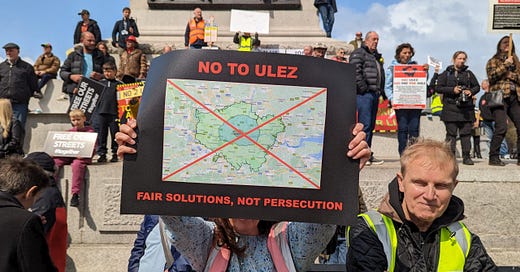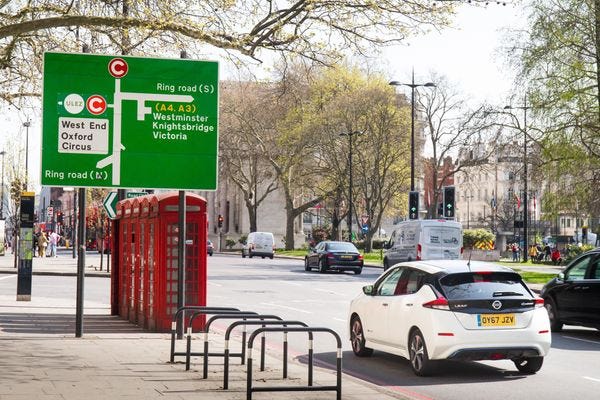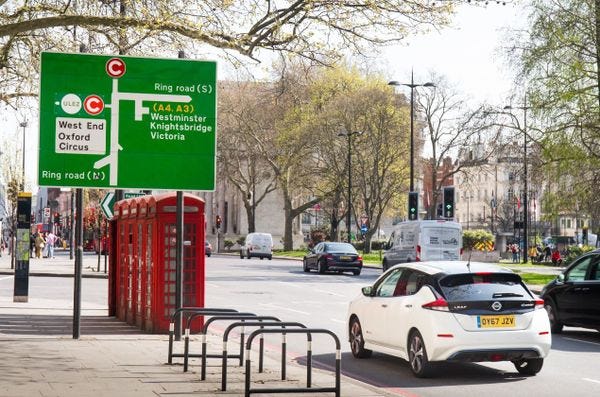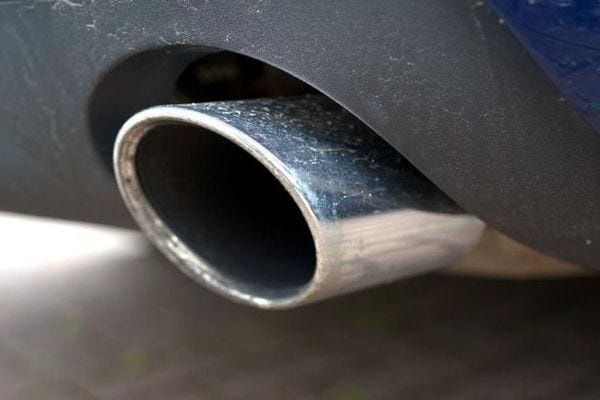This blog sets forth information regarding the enforced imposition of ULEZ “low emission zones” in London by Mayor Sadiq Khan and elsewhere in the UK.
The following is a reposting of Dr. Mike Yeadon’s Telegram post which was brought to our attention by the UK Column’s Alex Thomson.
It’s obvious that Khan has cleverly placed a “Chinese Wall” of his own staff between the ongoing consultation about ULEZ expansion and the Mayor himself.
It’s simply not credible that the handful of people who report to the Mayor did not once mention the state of the consultation at any point along the timeline.
I’ve been at mid corporate levels in large MN corporations and CEO of a privately funded biotech.
If, in an enquiry about a decision I’d made & the underlying work that I said had informed my decision, I denied learning ANYTHING about how it was progressing at any point from several staff who’s jobs, bonuses and progression was largely in my hands, despite all of those staff having attended several update meetings on the state of play, there would have been a number of consequences:
1. No one would believe me. Those of us who’ve held analogous positions know full well that we WOULD have been briefed, if not in detail (probably wouldn’t have been in detail), then in broad brush & CERTAINLY about “hot button” topics.
2. If I repeated the assertion to the Board, that I’d known NOTHING until the final report date, they’d have sacked me. How would I have warned stakeholders if things were off track? I’d have been instructed in terms that my conduct had fallen far below that expected, etc. They’d have expected me to know about, yet not to act in ways prejudicial to, oxthe publicly declared process. This is NORMAL. Khan knows this (so I assert he was briefed along the way & I don’t know why he’s lying here). The more senior you get, the more important is to know what is going on & to steer judiciously.
3. What is even worse is the lack of objective information prior even to have decided anything about ULEZ (let alone it’s expansion). My training does include respiratory particulate deposition (as opposed to entry) in the airways, the theoretical concerns, the experimental evidence (I’m the author of several papers on impact of ozone (O3) on pulmonary function) of real harms, such that defensible limits could be set. I’m of the expert opinion that NOTHING is needed to bear down on air quality. The battle was long ago won & it’s a good thing too. In short, the air is so clean in London in relation to vehicle emissions that further changes would no measurable difference. A grand total of zero lives will be saved by essentially disabling a growing proportion of the population by further measures. The entire air quality issue is now politically a much bigger concern politically than ever it was when it was killing thousands a year.
4. Swapping out older internal combustion engined vehicles & replacing them with EVs probably would change nothing about air quality and it may even increase transport related deaths. The transition is pushing poorer people out of their legally purchased & operated cars into public transport. Air quality is measurably worse there. For example in London Underground, the level of respirable particulates from metal wheels & tracks, from brake linings, from dust forcibly driven into the air path of the passengers, is much higher now than ever it was, anywhere above ground, relating to private vehicle originated emissions.
Given the foregoing, it’s obviously relevant & represents an intolerable conflict of interests that Khan is doing anything to make private car/van transport tough to use.
Why do I say that? He’s a very senior & important member of a UN-initiated, GLOBAL group called the C40 Cities program, and their goals, in a nutshell, at identical to a subset of The Great Reset & the UN2030 sustainable development goals. These are intended to PERMANENTLY DEPRIVE us of personal transportation and thereby trap us in so-called “15 minute zones”.
If this sounds completely incompatible with a thriving, healthy and happy human community, you’re absolutely right. I’ve uncovered other evidence, unrelated to Khan, that is absolutely compelling and has as endgame FAR fewer people. Bluntly, those I call “the perpetrators” intend to murder the vast majority of us.
This is the description for the video below:
Sadiq Khan GRILLED over ULEZ dishonesty (Mayor's worst day ever?)
Watch Peter Fortune AM methodically question Sadiq Khan on the ULEZ consultation process, when he and his senior staffers were briefed and why he made false and dishonest statements to the London Assembly.
It should be noted that in 2021, Sadiq Khan was “accused by a minister of “the height of hypocrisy” after he was spotted in a convoy of three cars that drove him miles across London to take his dog for a walk after hiking congestion charges for other drivers.” Source
Please note that a legal challenge to Khan’s Ulez launched by London Tory councillors was quelled by the High Court. Ross Clark expresses his opinion on this in the article published by The Spectator below.
Tories should never have taken their Ulez challenge to court
By Ross Clark • 28 July 2023, 10:58am
Expanding London’s Ultra Low Emission Zone (Ulez) may be a bad policy, a regressive tax which will impact on people of modest means while leaving the not-very-much-less-polluting cars of the wealthy untouched. But that doesn’t mean the High Court is wrong to reject the case brought by Conservative councils against the scheme. On the contrary, anyone who values democracy should be pleased that Ulez has been thrown back into the political arena, where it belongs.
It is alarming the way that so many matters of public policy now end up being dragged through the courts under the judicial review process. How we impose motorist taxes, whether we build rail lines, runways and so on should be a matter for our elected representatives – whom we can punish through the ballot box for bad decisions – not for unelected judges. For a judge to have the ultimate say over a political decision like this turns us into a kritarchy – the rule of judges.
The High Court case never was about the merits of Ulez. It was about the legality of the process by which London mayor Sadiq Khan made his decision to expand the zone. The councils who brought the case contested that he hadn’t consulted properly and that he didn’t have the powers actually to introduce the scheme. Given that London already has a Ulez which stretches up to the North and South Circular, and has had a congestion zone for the past two decades, this latter claim always did seem a bit far-fetched: how could it be legal for the mayor to introduce a scheme up to the existing limits but illegal to impose it in areas beyond those roads but which still come under his jurisdiction?
Taking campaigns like this to the court always does look a bit desperate, but in this case it looks to have been counter-productive. A week ago, after the Uxbridge by election, Sadiq Khan was on the back foot, being ordered by his own party leader to think again about Ulez. Now he can claim a victory, giving him momentum to introduce the scheme as planned next month.
Today’s decision doesn’t mean, of course, that Ulez will turn out to be popular, that there won’t be a large number of motorists – think nurses on night shifts, carers needing to travel between appointments, tradespeople needing to cart about large amounts of kit – who will feel aggrieved at the expansion of Ulez. But it does mean that the ultimate judgement on the scheme will be delivered where it should be: at the ballot box in next year’s mayoral election. After Uxbridge, opponents can at least hope.
This was an interesting 11 minute discussion on GB News earlier today:
For more details regarding the implementation of the UN Agenda 2030 inspired ULEZ see the following article published by Auto Trader 4 August 2023.
ULEZ Expansion: Is Your Car Compliant, and What Happens Next?
London’s ULEZ has expanded, and more UK cities are adopting clean air zones. Find out what this means for you and find ULEZ compliant cars for sale.
Words by: Andrew Woodhouse • Last updated on 4 August 2023 | 8 min read
The Mayor of London, Sadiq Khan, has recommitted to expanding the ULEZ across London by 29 August 2023, vowing “not to step back from tackling air quality and taking climate action to safeguard the health and future of every Londoner”.
The ULEZ (Ultra-Low Emission Zone) was originally introduced in 2019 and applies to cars and motorcycles.
ULEZ charges are applied to:
• Diesel cars and vans that don’t meet Euro 6 Standards
• Petrol cars and vans that don’t meet Euro 4 Standards
• Motorbikes that don’t meet Euro 3 Standards
You can learn more about Euro Standards, and the charges applied, further down this page.
Khan also announced a massive expansion of scrappage scheme to all Londoners, offering scrappage grants of up to £2,000 to every single Londoner with a non-compliant car or motorcycle. This expansion will be in effect from 21 August 2023. You can learn more about the scrappage scheme here.
This scrappage scheme will help many more drivers, including those who drive vans or minibuses, switch by making it more affordable.
The conversation around the ULEZ and other Clean Air Zones across the UK can be tricky to follow – with lots of jargon, questions and changing deadlines to keep up with.
So here, we lay out what a ULEZ-compliant car is, so you can make you next purchase in confidence.
ULEZ compliant cars
Vehicles needs to meet different emission standards to travel through ULEZ, or other low emission zones, without paying a charge. If your car exceeds the emissions standards set for the zone, you may have to pay a charge to enter.
As the driver, it’s your responsibility to check you’re compliant. You can use the Government’s clean air zone tool to see whether you’ll need to pay - you’ll just need your number plate to start.
ULEZ compliant cars meet the emission standards, as set out below.
ULEZ compliant petrol cars for sale
Petrol cars must meet Euro 4 emissions standards to be ULEZ compliant.
Most, if not all, petrol cars registered since January 2006 meet these standards.
Petrol cars that meet Euro 5 and Euro 6 standards are also exempt from paying charges.ULEZ compliant diesel cars for sale
Diesel cars must meet Euro 6 standards to be ULEZ compliant.
Almost every diesel car registered since September 2015 meets these standards, though some earlier models do too (you can find some ULEZ compliant diesel cars going back to 2012).
ULEZ compliant hybrid cars for sale
To be ULEZ compliant, hybrid cars must meet the same standard as petrol or diesel cars. So petrol hybrids (the most common type), must meet Euro 4 standards and diesel hybrids must meet Euro 6 standards.
ULEZ compliant electric cars for sale
All electric cars are ULEZ compliant, as they produce zero tailpipe emissions.
Find ULEZ compliant electric cars for sale and learn more about electric cars on Auto Trader.If you opt for the scrappage scheme and get the two grand, there are nearly 5,000 ULEZ compliant cars for sale for under £2,000, with more being added all the time.
Electric cars are ULEZ compliant
Is my car ULEZ compliant?
You can find out if your current car is ULEZ compliant by checking the vehicle logbook for the “vehicle’s minimum emission standard”. In newer vehicles, the emission standard may be listed on the V5C in section D.2. Alternatively, you can try asking the vehicle manufacturer.
London ULEZ checker
You can check whether your vehicle is ULEZ compliant by entering your registration number into the TFL ULEZ checker.
Just be aware that sites like these aren’t 100% accurate. There have been cases where people have been told their car is Euro 6 compliant, then received a fine as that wasn’t the case.
You should investigate properly. The most accurate way to find out if your car is ULEZ compliant is to ask your manufacturer or refer to the handbook and confirm for yourself.
Related: ULEZ expansion in London confirmed from 29 August 2023 onwards
Can I sell my car if it isn’t ULEZ compliant?
Yes, you can still sell your car. If you’re selling in cities like London, potential buyers will be in the same situation as you – so you might not fetch as good a price or might find your advert is listed for longer.
But you can look at advertising further afield, or save even more time by getting an instant cash offer for your car.
We’ll give you a quote in minutes and can arrange to collect your vehicle from you in as little as 48 hours.
Learn more about your options when it comes to selling your car.
London's ULEZ zone has expanded
What are European emission standards?
European emission standards represent an acceptable amount of pollution emitted by a vehicle’s exhaust, and are measured using WLTP and RDE tests.
To improve air quality and reduce pollution, all vehicles must meet European emission standards. The sixth, and latest, set of standards (called Euro 6), was released in 2015.
Higher Euro numbers (e.g. Euro 5 and Euro 6) mean it’s a newer engine with cleaner emissions. Lower Euro numbers are used for older and more polluting engines.
The aim of European emission standards is to reduce the levels of harmful emissions, including carbon monoxide, nitrogen oxides, hydrocarbons and particulate matter.
More information on ULEZ and London’s Low Emission Zones
What is London’s ULEZ?
On 25th October 2021, the London Ultra Low Emission Zone (ULEZ) extended further from Central London, creating a larger single zone from the North Circular Road (A406) to South Circular Road (A205). It was recently announced that London’s ultra-low emission zone will be extended to the whole of Greater London by the end of next year.
ULEZ was originally introduced in 2019 and, unlike the surrounding low emission zone, the criteria apply to cars and motorcycles.
ULEZ charges are applied to:
• Diesel cars and vans that don’t meet Euro 6 Standards
• Petrol cars and vans that don’t meet Euro 4 Standards
• Motorbikes that don’t meet Euro 3 Standards
ULEZ charges
Non-compliant vehicles will have to pay £12.50 per day to enter, on top of the congestion charge (£11.50 per day).
If you don’t pay, you face a £160 fine per day.
Buses, coaches and lorries will need to pay £100 per day if they don’t meet or exceed Euro 6 Standards.
Is ULEZ only in London?
London’s ULEZ is the world’s first 24-hour ultra-low emissions zone.
There are plans for low emission zones, with slightly more lax criteria, in other UK cities.
London’s ULEZ is within a wider low emission zone itself.
What is the London low emission zone?
London’s low emission zone gives us a clear example of how low emissions zones could work in the UK.
Launched in 2008, it operates 24/7 and covers most of Greater London. Charging days run midnight to midnight, so if you drive through the zone from 11pm to 1am, you’d need to pay for two days.
The low emission zone currently applies to heavy vehicles and vans, but not currently cars. Inside the London LEZ is London’s ultra-low emission zone (ULEZ).
ULEZ and clean air zones are designed to cut emission levels in cities
Learn more about UK low emission zones
What are low emission zones?
Low emission zones aim to improve air quality by discouraging or restricting polluting vehicles, usually by charging them to enter.
They are normally found in city centres with heavy traffic, low emission zones encourage the use of electric vehicles, hybrids and other alternative fuel vehicles.
Another name for low emission zones is clean air zones (CAZ).
Can I drive in low emission zones?
Currently, you are not banned from driving through low emission zones, but you may be charged for doing so.
There are four classes of low emission zone, and they each charge different types of vehicle:• Class A charges buses, coaches, taxis and private hire vehicles (PHVs)
• Class B charges all in Class A plus heavy goods vehicles (HGVs)
• Class C charges all in Class A and B, plus light goods vehicles (LGVs)
• Class D charges everything above and cars
As of writing, the only Class D low emission zones in the UK are in London and Birmingham. Other cities are set to introduce low emission zones, including Bradford, Sheffield and Greater Manchester (under review). See below for the latest list.
How do low emission zones work?
There are currently two types of low emission zone: charging and non-charging.
Non-charging low emission zones
In non-charging low emission zones, measures such as rerouting traffic and retrofitting polluting vehicles are taken to keep vehicle emissions in highly polluted areas down.
Charging emission zones
In charging low emission zones, Automatic Number Plate Recognition (ANPR) cameras log cars as they drive into the zone. If the vehicle doesn’t meet the standards, drivers are then automatically sent a bill. If you don’t pay, you’ll just face heavier penalties and it’ll cost you more in the long run. There aren’t any barriers or toll booths.
London’s Ultra Low Emission Zone (ULEZ) was the first charging low emission zone in the country. Similar plans have been announced for cities like Bath and Birmingham in the near future.Is my vehicle exempt from LEZ?
You may be exempt from LEZ charges if the following applies to you:
• You have a military or historic vehicle • You have a disabled passenger tax class vehicle • Your vehicle is classed as ultra-low emission (see below) • Your vehicle is retrofitted with Clean Vehicle Retrofit Accreditation Scheme (CVRAS) technology. There may also be local exemptions, so contact your local council for more information. You can view the full list of exemptions here.Where are the low emission zones in the UK?
There are currently low emission zones in:
• Birmingham• Brighton
• Glasgow
• Leeds
• London
• Norwich
• Nottingham
• Oxford
Members of the public only have to pay to enter the low emission zone in London, other low emissions zones are only for buses. That said, it’s likely other vehicles will be charged to enter in the coming years.
Other cities said to be working on low emission zones are Bath, Bristol, Cardiff, Derby, Hull, Manchester, Middleton, Sheffield and Southampton. Plans for a Clean Air Zone in Leeds have been put on indefinite hold as businesses have switched to cleaner vehicles faster than expected, and air pollution in Leeds is now significantly below legal limits and is not likely to exceed them again.
The Scottish Government has also announced schemes in a number of cities.
How much will I have to pay to enter a LEZ?
Charges will be issued by local authorities, and these charges may vary depending on the type of vehicle you drive and its purpose (taxis and private hire vehicles may be charged differently, for example).
You can check if you’ll need to pay here.
According to Dr. Yeadon and in the opinion of many of us here in the UK, ULEZ has absolutely nothing to do with concerns about our health.
It has everything to do with money, power and control.









If I were faced with that (and I imagine i will be too one day soon, especially if it's not snuffed out there, NOW), I would not comply. And I would encourage everyone else to not comply with me. It's insane to even entertain this idiocy. I would definitely not be playing in their sandbox (e.g. protesting, using their BS language made up to make it all sound legit, etc.). It just is simply a NO-GO. Not legit. And should be given no legitimacy. That's how I felt and operated during COVID. It's sad that so many think this is okay.
Why do the people entertain these RIDICULOUS ideas. Just say NO WAY!!!!!!!